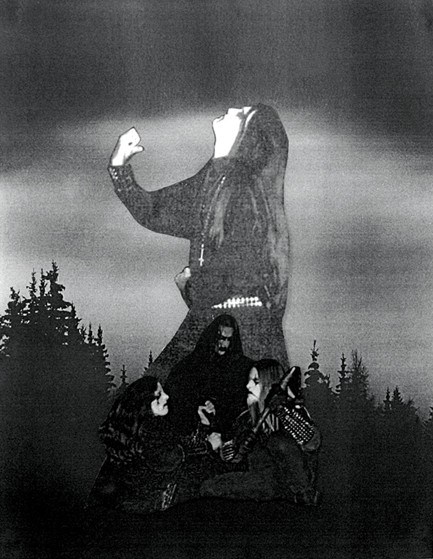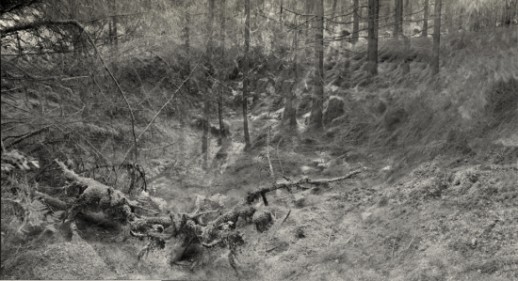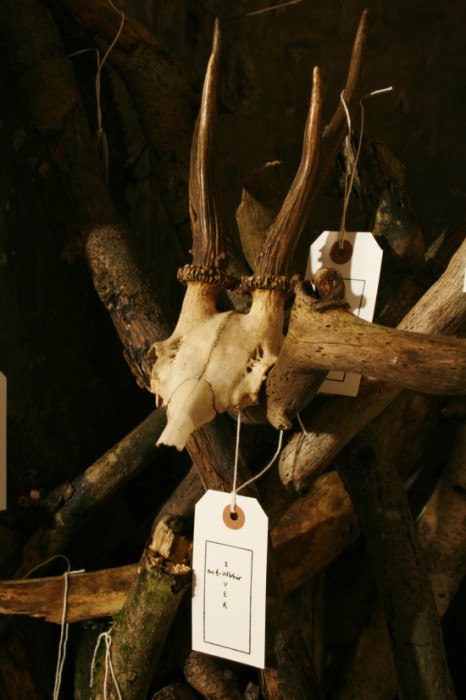Camilla Nelson on an exhibition curated by Amy Cutler that explored forests, memory and social and cultural history.
This exhibition brings together an eclectic crowd of tree-related materials that range from tree specimens – the dendrological items on loan from the Kew Museum of Economic Botany – through a complex amalgam of tree and human interrepresentation – birch bark written over with pen and ink (Zoe Skoulding) or bitten into birch marks (Chris Drury), film strips of decayed leaves (David Chatton-Barker), the sounding insides of trees (Will Montgomery) and the markings of ash on paper (Carol Watts and Herman de Vries) – to the more familiar paper forms of drawing, written text and photograph. Not forgetting the bureaus, cupboards, pews and desks which, although not obviously items ‘on display’ here, form an important registry of how human habitation is informed by our relationship with trees and, vice versa, how the history of trees and their growth is informed by human habitation. This gathering together of tree-related material constitutes a form of physical essay that can be walked through, or inhabited, working across a range of senses, suggesting the different ways in which trees are re-membered through human interaction and how our interaction with trees re-members us in turn.
For me, one of the most memorable counterpoints of the exhibition was between Zoe Skoulding’s hand written text of ‘In The Forest Where They Fell’, transcribed onto peeled silver birch bark by the author, and the marks Chris Drury had made by biting into birch bark after the manner of Alquoquin, a group of languages thought to be 11000 years old spoken by tribes in an area encompassing parts of North Dakota, Michigan, Manitoba, Ontario and Quebec, whose written components were made by folding birch bark and biting into it to leave differently angled bite marks in the bark. Chris Drury’s piece pays tribute to this ancient method of human meaning-making through tree-marking. The physical imprint of teeth in the text produces a strange hybrid of spoken word, formed in the mouth, and writing. In both Skoulding and Drury’s pieces there is an interesting synergy between the lenticel lips, the mouths, or breathing holes in the bark, natural to the tree, and the imprints made into or onto the bark of the tree that memorialise the human hand and mouth (and/or teeth) in writing.
The ash tree works were another highlight in this treasure trove of tree material. In the handout Amy Cutler notes how ‘the spectre of ash dieback haunts this exhibition’. Works by Herman de Vries and Carol Watts memorialise the ash tree by marking its ashes into the paper page. Carol Watts’ ‘Ash Pastoral’ is a two part piece composed of a small artist’s book whose pages are marked with burnt ash, and a poem that meditates on the ‘sourcings of voice’, the ‘soundings of ash’ and the ways in which agents of composition are ‘marked out’. Watt’s work conveys an uneasy sense of being absented by the very effort of representation, of forgetting in the act of striving to remember. Both page and charcoal evidence the destruction of that which the author aims to presence, the materials of representation are complicit in the die back they mean to lament.
The opening night of this exhibition was also the occasion of the launch of Amy Cutler’s Forest Nostalgia (Oystercatcher Press). In many ways the format of this text provides a literary parallel to the exhibition itself. In Forest Nostalgia Cutler brings together a collection of diagrams, sourced from disparate locations, and text, from Paul Ricouer’s (2000) Memory, History and Forgetting, to forge an innovative series of word-image conjunctions. Each diagram presents an effort to communicate a certain feature of a tree, or trees, in order to improve our human use and understanding of these trees. The disjuncture between these diagrams, our shadowy sense of their ‘original’ use, and Ricouer’s fragments quoted beneath each diagram, provokes a sense of happy coincidence and jarring mismatch. This self-conscious arrangement of two voices speaking together who have no sense of what the other is saying approximates ‘une dialogue de sourdes’ to which the reader inevitably ascribes some sort of narrative relation. This combination of allusion and suggestion is both tentative and fertile in its open undidacticism. Cutler holds these diverse textual fragments together with a loose generosity, as she does the items in the exhibition, there are no forced conclusions; each page is a gift for the reader to take from it what they will. Forest Nostalgia is a text in the true sense of binding or weaving together divergent threads. This particular text creates an open weave through which the reader may see their own hand at work, holding it in place.
Both text and exhibition propose a variety of methods for recording and remembering trees, whilst also constituting a re-membering and aligning of items that may never have been bound together so closely before. Both text and exhibition forge not just one path through the woods but many. Together, both book and belfry, provide a palimpsest of forest paths upon which the reader and/or exhibition visitor gradually gains an uncanny and disorienting sense that each of their feet falls onto many paths at once: these paths are being remade as they are being remembered.
Time, the deer, is in the wood of Hallaig was curated by Amy Cutler and installed in the belfry of St. John on Bethnal Green and ran in June 2013. It included the tree-related work of over forty artists. An online catalogue of the exhibition will be available shortly from Amy Cutler’s website.


